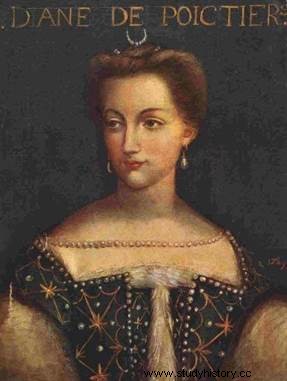 Diane de Poitiers (1499-1566), favorite of King Henry II of France, imposed herself on the royal court at the expense of Queen Catherine de Medici, and surrounded herself with a brilliant court. An independent woman, she knew how to preserve the youth of her body and her mind. She never forgot her principles "always be in honorable bearing, in a cold and assured manner, humble gaze, low speech, constant and firm, always in one word, without flinching, moderation in all things". She also succeeded in transforming Henri, making this awkward and clumsy young man a troubadour, a poet, a cavalier and a monarch. After the king's death, she retired to Anet, where she died on April 22, 1566.
Diane de Poitiers (1499-1566), favorite of King Henry II of France, imposed herself on the royal court at the expense of Queen Catherine de Medici, and surrounded herself with a brilliant court. An independent woman, she knew how to preserve the youth of her body and her mind. She never forgot her principles "always be in honorable bearing, in a cold and assured manner, humble gaze, low speech, constant and firm, always in one word, without flinching, moderation in all things". She also succeeded in transforming Henri, making this awkward and clumsy young man a troubadour, a poet, a cavalier and a monarch. After the king's death, she retired to Anet, where she died on April 22, 1566.
A renaissance lady
Daughter of Jean de Poitiers, Diane, so named in homage to the goddess of the hunt, was born on December 31, 1499, in the family castle in Dauphiné. She will later inherit from her grandfather the castle of Saint-Vallier, the title of Countess of Valentinois and the emblem of Poitiers. On the day of his birth, an old woman came to predict that the star of the child would raise him higher than a queen.
At the age of six, she went hunting with her father, had her own falcon and became a skilled rider. On the death of her mother, she joined the court of Anne de Beaujeu and Louis XII, learning Latin, Greek, theater, dance, philosophy, Plato's logic and above all the contempt for intrigue, the dignity rank to hold, nobility of taste, the art of conversation, in short everything that made a true Lady of the Renaissance. Maid of honor to Queen Anne, then to the future Queen Claude, wife of François 1er, she attended the king's coronation in 1515.
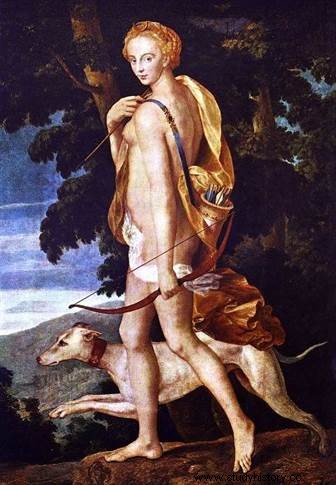 On March 29, 1515, she was married to Louis de Brézé Grand Seneschal of Normandy, hunter emeritus, rich, powerful , very well titled. Diana, with a slender figure, an aristocratic bearing, blonde with a high forehead, white and pale skin, gray-blue eyes, straight nose, a small mouth with full lips, thus achieved a royal rank just below that of princess:the 3rd rank in the kingdom. Their home is Anet, a grim and ruined dwelling. During the king's visit to Rouen, Louis de Brézé gave him the keys to the city and welcomed him into his home. The Court quickly realized that the Grand Seneschal of Normandy took her marriage very seriously and did not allow herself to be conquered by courtiers, so much so that François 1er annotated a portrait of Diana "beautiful to see, honest to haunt" in 1520 .
On March 29, 1515, she was married to Louis de Brézé Grand Seneschal of Normandy, hunter emeritus, rich, powerful , very well titled. Diana, with a slender figure, an aristocratic bearing, blonde with a high forehead, white and pale skin, gray-blue eyes, straight nose, a small mouth with full lips, thus achieved a royal rank just below that of princess:the 3rd rank in the kingdom. Their home is Anet, a grim and ruined dwelling. During the king's visit to Rouen, Louis de Brézé gave him the keys to the city and welcomed him into his home. The Court quickly realized that the Grand Seneschal of Normandy took her marriage very seriously and did not allow herself to be conquered by courtiers, so much so that François 1er annotated a portrait of Diana "beautiful to see, honest to haunt" in 1520 .
After having given birth to little Françoise in 1518, her father Jehan, caught in spite of himself in the plot fomented by Charles V and Charles de Bourbon, was arrested in September 1523, led in Loches, deprived of all his property, sentenced to death, then justly pardoned in February 1724 for life imprisonment. Rumor has it:Diane would be the King's mistress! Not only was the king insane, but on the death of his wife, he entrusted the custody of his children to Diane in July 1524:a great honor.
During the exchange of Francis I captive of Charles V for his children, Diane supports eight-year-old Francis and six-year-old Henry with her comforting words. The king, back in Rouen, took advantage of the hospitality of the Brézé in Anet and conquered by the righteousness, intelligence and culture of Diane, he offered her a new place at court:lady-in-waiting to her mother Louise of Savoy.
The meeting with the dolphin Henri
At the beginning of the summer of 1530, the royal children returned. The young Henri, disappointed by his father, turns to the only two people who have shown him affection:Diane and Anne de Montmorency. The children spent the autumn in Anet with Diane and Louis de Brézé, then returned to Saint Germain. During the tournaments in honor of the new Queen Eléonore, sister of Charles V, the young Henri chooses his lady:Diane. For the election of "the beautiful among the beautiful", Queen Eléonore, the king's mistress Anne de Pisseleu and Diane de Poitiers are in competition. As the king's mistress and Diane are on an equal footing, Anne de Pisseleu, vexed, will have only one goal in her life:to destroy Diane.
In July 1531, Louis de Brézé died. From that date, after 17 years of happy life together, Diane only wears black with a few touches of white. To its coat of arms, it adds the symbol of a widow:a torch turned downwards and its motto is "he who ignites me has the power to extinguish me".
Retiring to Anet, following the disappearance of the regent Louise of Savoy, Diane takes care of her. She practices a strict lifestyle, washes with clear water, takes an ice water bath at all times, a broth in the morning, 3 hours of horseback riding at high speed, a small snack at 11 a.m. No cosmetics, no sun, skin always white, dressed in silk, she attaches to her shoulders rows of pearls crossing over a black velvet bodice with a deep neckline, the end of the sleeves in fine muslin, stones precious to her size, Diane settles the affairs of her estates, grants audiences, dines at 6 p.m. and goes to bed.
Diane de Poitiers, favorite of Henry II
Recalled to court in the fall of 1533, Diane, a close relative of Catherine de Medici, future wife of Henri, was chosen to guide her and explain French rituals and customs to her. Grandiose receptions, masked balls, endless banquets for this princely wedding… Diane is dressed in black and white, wears feathers of the same colors… Henri wears the same black and white feathers on his hat! He does his duty as a husband and immediately returns to his Lady. From the age of 6 until his death at the age of 42, Henri will devote a real adoration to Diane de Poitiers.
Appreciated by the king, very often invited to hunt, Diana has to face the aggressiveness and hatred of the royal mistress who launches slander and rumors of belonging to witchcraft. We witness the formation of 2 camps:that of the king's mistress and that of Diana. At this moment, Henri openly takes up her defense, in front of the entire court, and reiterates his oath of devotion to Diane. Diane, for her part, supports the king and Henri during the “Affaire des Placards”, organized by the Reformed against the Catholics.
Henri, who has become a dolphin (François has just died), asserts himself, shares his opinions and feelings with his friends. Diane knows how to use her intelligence and her charm and is not unaware of the means to achieve her ends. They became lovers at the end of 1536 or the beginning of 1537, certainly at the Château d'Ecouen, Anne de Montmorency's favorite residence. On the morning of their first night, Diane writes a little poem (of which here is a passage) and sends it to Henri:
“Here truly is Love, one fine morning,
He came to offer me very nice flowers…
Because, you see, such sweet flowers
Were boyish, fresh, up and young.
…
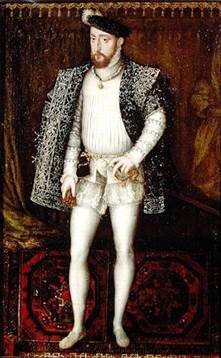 Henri radiates happiness thanks to the constant presence of Diane by his side. Diane discovers with him the pleasure that an adolescent lover gives, she transmits to him all her knowledge acquired alongside Louis de Brézé. She does not seek Henri's love, but she does everything in her power not to let it die out, she holds him back by the power of her mind and her intelligence, until she becomes godmother in 1538, of little Diane d'Angoulême (daughter of Henri and Filippa Duci). She will be married to the son of Anne de Montmorency, Françoise (1st daughter of Diane) married to Robert IV de la Marck, and the 2nd daughter of Diane to a Guise. But the Guises impose themselves too much:Catherine de Medici still having no children, they propose a new wife for Henri II, young, beautiful who risks taking Diane's place in Henri's heart.
Henri radiates happiness thanks to the constant presence of Diane by his side. Diane discovers with him the pleasure that an adolescent lover gives, she transmits to him all her knowledge acquired alongside Louis de Brézé. She does not seek Henri's love, but she does everything in her power not to let it die out, she holds him back by the power of her mind and her intelligence, until she becomes godmother in 1538, of little Diane d'Angoulême (daughter of Henri and Filippa Duci). She will be married to the son of Anne de Montmorency, Françoise (1st daughter of Diane) married to Robert IV de la Marck, and the 2nd daughter of Diane to a Guise. But the Guises impose themselves too much:Catherine de Medici still having no children, they propose a new wife for Henri II, young, beautiful who risks taking Diane's place in Henri's heart.
The future queen and the mistress “stand together”:one implores the king, the other takes care of the dolphin. Diane takes Catherine aside, speaks to her gently, explains to her the art of making love. Some evenings, she sends Henri to his wife. Finally, the miracle occurs:Catherine gives birth to her first baby boy in January 1544. Henri, so happy, offers a sum of money to thank Diane for helping the Dauphine. Once again, the mistress had known how to make herself useful... But intrigues are going well at court, the royal mistresses hate each other, François 1er banishes Diane from the court, taking advantage that Henri has gone to war. Back from the campaign, he rushes to Anet.
The king, tired in February 1545, called Diane back to court, she resumed her position with Henry and was responsible for the education of 2 of the king's grandchildren. She feels that things will change very quickly after the death of François 1er and gets closer to the Guises. The revolution took place, in March 1547, when François 1st died. Anne de Montmorency is appointed head of the Privy Council. Henri claims the jewels from the royal treasury and offers them to Diane, she also receives the key to the vault as well as the authorization to draw from it at will. Henri seizes the house of Anne de Pisseleu and presents it to Diane. The latter takes pleasure in receiving all these honors, but does not lose her head.
Queen or royal mistress?
Diane is very interested in the government, in the functioning of the finances of the kingdom. She pushes Henri to create sumptuary laws (limitation of expenses) concerning distractions, the splendor of the court, she encourages him to reduce the number of courtiers, and to introduce new social measures (each district of Paris should constitute a fund welfare for the poor, hospitals should take in the sick and infirm). To thank her and prove his love for her, Henri offers her the most beautiful jewel of the Loire:the Château de Chenonceau, which will become even more magnificent after the transformations carried out.
On the day of Henry II's coronation in July 1547, the king's costume caused a scandal:the embroidery recalls the attributes of Diana (quiver, bows, arrows, crescent moons, double D attached to the H), the letter C of the queen does not appear anywhere! When Catherine's third child was born, Diane decided on the governess, the feeding of the children, their education. Only Diane's word counts. For the holidays in Lyon in September 1548, everything was black and white, from the uniforms of the soldiers to the harnessing of the horses. During these ceremonies, Diane accedes to the highest dignity of people who were not born princesses:Duchess of Valentinois. In May 1549, the spectacle given in Paris was even worse than the previous one:all the letters were "tied H and D", everything was black and white. Henri trusts only Diane, she signs official letters "HenriDiane", participates in the Privy Council, but is not immune to malevolence and must fight against rumors:she would be at the origin of the persecution of heretics. Henry II is there for her.
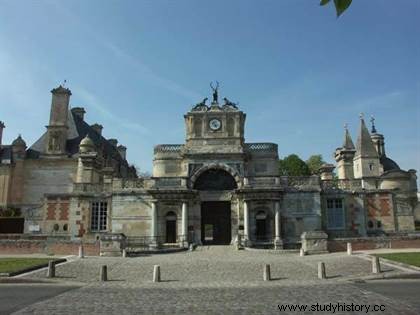 They spent weeks at Anet, hours on horseback early in the morning as well as hunting and magnificent banquets close the evenings. Henri had portraits made of his favorite:from this period dates the tradition of portraits in the bath. Anet is a paradise:Henri recovered from his imprisonment in Spain, the royal children stayed there with a good heart, the king liked to spend long hours in the library (all the books were bound in red morocco adorned with the cipher of the king and his lady, one of the most prestigious collections of the Renaissance). Henri made Anet the seat of his government, writing letters there and granting audiences.
They spent weeks at Anet, hours on horseback early in the morning as well as hunting and magnificent banquets close the evenings. Henri had portraits made of his favorite:from this period dates the tradition of portraits in the bath. Anet is a paradise:Henri recovered from his imprisonment in Spain, the royal children stayed there with a good heart, the king liked to spend long hours in the library (all the books were bound in red morocco adorned with the cipher of the king and his lady, one of the most prestigious collections of the Renaissance). Henri made Anet the seat of his government, writing letters there and granting audiences.
Diane is much appreciated by those around her. Little Marie Stuart was entrusted to him on his arrival in France. She takes in "her luggage" her governess:Lady Fleming who has an affair with Henry II... Diane is bedridden because of a fall from her horse. He does everything to hide this affair, but the royal mistress can count on her friends! Lady Fleming is sent back to Scotland. Diane is extremely angry to learn that Anne de Montmorency is involved in this story:in fact, he wants to remove Diane from power. The children of Catherine and Henri will reconcile the constable and the king's mistress.
During the war years 1552 to 1557, the queen and the royal mistress had to rub shoulders, despite the many differences:"Diana went one day to Catherine's apartments, he was reading. Interested Diane asks her what she was reading:“I read the histories of this kingdom, and I find there that, from time to time in all ages, whores have directed the affairs of kings”. The insult goes around the kingdom. Diane takes her revenge by making Montmorency note that among the king's children, only Diane de France resembled the king...this comment is spreading in all the courts of the country!
The last years of Diane de Poitiers
After the truce with Spain, the parties began again, at weddings in 1558 and July 1559, with tournaments and jousting. And this is the famous accident of the king, fatally injured during a game. Diana rushes to him, but the queen forbids her passage definitively. This is the first time that Diane de Poitiers has felt totally helpless...she is afraid of seeing the King of France die, but above all afraid of suffering the Queen's revenge. Without Henri, she no longer has any authority. She goes back to her house and waits for the news. Not being invited to the funeral, she is content to watch the procession from one of her windows. The effigy of the king does not wear white and black, no crescent moons, the number HD does not appear on the harness of the king's horse. She was asked to return to the Château d'Anet and Queen Catherine de Medici offered her the Château de Chaumont sur Loire in exchange for Chenonceau:the deed of transfer was signed in April 1560.
On entering Chaumont sur Loire, the former property of the queen, Diane is horrified by all the traces of necromancy and alchemy left behind by Catherine:Greek, Egyptian and Hebrews adorned an altar on which stood a skull, vials of powder and jars of brine containing animal parts, strange books, parchments and animal remains. She burns everything down, closes Chaumont and bequeaths it to her daughter Françoise.
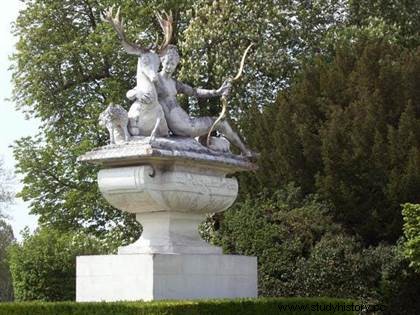 She joins Anet where all of Henri's memories remain. At the dawn of her 60th birthday, she is still a beautiful woman, enjoying good physical condition, despite a riding accident which broke her leg, she has just turned sixty-four.
She joins Anet where all of Henri's memories remain. At the dawn of her 60th birthday, she is still a beautiful woman, enjoying good physical condition, despite a riding accident which broke her leg, she has just turned sixty-four.
Brantôme wrote:"I saw this lady, six months before she died, still so beautiful, that I don't know heart of rock who was not moved, again that she had previously broken a leg on the pavement of Orleans, riding and riding as dexterously as she had ever done; but the horse fell and slipped under her; and, for such rupture and aches and pains that she endured, it would have seemed that her beautiful countenance had changed; but nothing less than that, for her beauty, her grace, her majesty, her beautiful appearance, were all the same as she had always had”.
Two years later, after a brief and serious illness, she died on April 26, 1566 in her castle of Anet, having divided her immense fortune between her two daughters and ensured bequests to a number of convents. During her funeral, a hundred poor people from the villages dressed in white accompanied the procession, singing “pray to God for Diane de Poitiers”.
Diane de Poitiers is buried in the funeral chapel she had built near the castle. French revolutionaries in 1795 opened the tomb and cut her hair for souvenir locks, then later an owner sold the castle stone by stone.
Bibliography
- Diane de Poitiers by Michel de Decker. Pygmalion, 2004.
- The moon and the serpent:Diana of Poitiers and Catherine de Medici, two rivals in the heart of the king by Marie-Christine de Kent. Pocket, 2007.
- Diane de Poitiers by Cloulas Ivan. Fayard, 1997.
